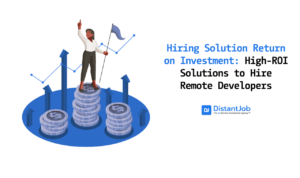Xamarin jumped to the market a few years ago with a game-changing solution that bridges the gap between Android and iOS, allowing businesses to expand to more flexible hybrid solutions. Nowadays, with over 13,000 apps built, Xamarin amounts to more than 2 billion downloads. This surge in popularity, however, does not ensure you quick and easy hiring of a Xamarin developer. Top-tier developers, including those proficient in Xamarin, often find themselves quickly engaged by projects or companies, leaving fewer available on the job market.
With many businesses competing for this talent. finding the right candidate may require a more strategic approach than simply searching for those candidates actively seeking employment. It’s important to make your offer stand out to attract the best developers.
In this article, we will break down the core responsibilities of Xamarin developers and provide a detailed roadmap for strategically hiring the right Xamarin programmer to enhance your development team.
What Does an Xamarin Developer Do?
A Xamarin developer specializes in using Xamarin to create and maintain mobile applications. Their role encompasses different responsibilities and skills, including:
- Cross-Platform Development – The primary responsibility of a Xamarin developer is to build mobile applications that work seamlessly across both iOS and Android platforms.
- User Interface (UI) Design – Design and implement user interfaces that are both appealing and functional on different devices.
- API Integration – They often work with various APIs (Application Programming Interfaces) to integrate third-party services and functionalities into the app, such as payment gateways, social media integration, or analytics.
- Testing and quality assurance – Use Xamarin’s testing tools and frameworks, like Xamarin Test Cloud, to identify and fix bugs, ensuring a high-quality, reliable end product.
- Maintenance and updates – Post-launch, they manage the app’s lifecycle, providing updates, performance enhancements, and bug fixes.
- Performance optimization – They continuously monitor and optimize the app for performance issues.
- Collaboration with cross-functional teams – work closely with other professionals like UI/UX designers, project managers, and quality assurance teams to ensure the project meets the required specifications.
💡 Related: Xamarin vs Flutter: A Comparative Guide
10 Essential Skills to Look In Xamarin Developers
When hiring Xamarin developers, there are several key skills to look out for. These skills ensure the developer can effectively utilize Xamarin’s capabilities to build high-quality, cross-platform mobile applications.
1. Knowledge of C# and ASP.Net
Xamarin enables C# developers to build apps for Android, IOS, and Windows. So, when interviewing candidates, one of the essential skills they should have is proficiency in C#.
You can also filter candidates by asking them about Model-View-ViewModel (MVVM). Cross-platform app development frameworks are based on MVVM, a software design pattern, so all Xamarin developers should have a solid understanding of it.
2. API and Third Party Libraries
Xamarin provides extensive support to APIs and third-party libraries. You could ask candidates about previous projects to understand their familiarity with these helpful options.
3. Reusability of Code Across Platforms
As explained, Xamarin can create apps for both Android and iOS platforms, but there is some setup required if you want your code to work on both platforms at once. Skilled Xamarin developers would have no trouble describing how they reutilize the code set from one platform to another.
4. Experience with Xamarin Forms and Xamarin Native
Knowledge of both Xamarin Forms for shared UI code and Xamarin Native (Xamarin.iOS and Xamarin.Android) for platform-specific code is important for versatile app development.
5. Knowledge of XAML
Proficiency in XAML (Extensible Application Markup Language) is beneficial for designing user interfaces in Xamarin Forms.
6. Testing and Debugging
Experience in testing and debugging, using tools like Xamarin Test Cloud, to ensure the app performs optimally on various devices and platforms.
7. Version Control Systems
Familiarity with version control systems like Git is important for managing codebase changes and collaborating in team environments.
8. Performance Optimization
Skills in optimizing app performance to ensure efficient memory usage, responsiveness, and battery optimization.
9. Previous Work
One of the best ways to understand how a candidate works and their level of knowledge is through their previous work and learning experience.
Ask them about what resources they seek when getting stuck or which are their favorite websites to learn about something in particular. Also, ask about their previous work and see what they have created in the past.
10. Proficiency in IDEs and Build Tools
When selecting a Xamarin developer, it’s crucial to assess their ability to efficiently transform source code into high-performing applications.
Look for experience with IDEs such as Xamarin Studio, Visual Studio (often the primary IDE for Xamarin development), Xcode, and Android Studio. These platforms are fundamental in creating, testing, and deploying cross-platform applications.
How to Hire Xamarin Developers?
Hiring an Xamarin software developer requires a structured approach to ensure you find a candidate who has the right skill set and experience your project needs. Here’s how to get started:
1. Deep Dive into Xamarin Specialization
You can’t successfully hire Xamaring engineers if you don’t understand the framework itself. From its cross-platform capabilities and integration with .NET to its features and limitations, evaluating Xamarin developers is knowing whether they have the skills for the project or not.
Focus on identifying key skills specific to Xamarin, such as experience with Xamarin.iOS and Xamarin. Android, understanding of .NET and C#, and familiarity with MVVM design patterns.
If you’re not familiar with Xamarin, consider hiring through third-party services like recruitment agencies that have the expertise to make thorough evaluations.
2. Specific Project Requirement Analysis
Not all Xamarin developers perform the same tasks and have the same responsibilities. To hire the right candidate, start by analyzing the technical demands of your project. Does it require integration with existing systems, specific UI/UX design skills, or unique APIs?
Assess the scale (e.g., small, medium, large) and complexity of the project to understand the level of expertise required. This will help you set a clear guideline of the type of skill set and expertise your Xamarin developer needs to have.
3. Targeted Xamarin Talent Sourcing
Once you have the first two steps covered, it is time to begin with the search. While regular job boards like Glassdoor or Indeed can help you bring potential candidates, when it comes to specific and highly technical roles like Xamarin, in most cases, you need a different approach.
Start by identifying where Xamarin developers are most active, This may include LinkedIn, GitHub or Xamarin forums.
If you’re still struggling to find or attract candidates, consider partnering with IT staffing agencies. Their experience in the field can significantly streamline your hiring process, connecting you with top-tier Xamarin talent tailored to your project’s specific needs.
4. Advanced Technical Evaluation
Don’t focus on generic or repeated tests when evaluating Xamarin developers. Depending on your project needs and the skill set you’re looking for, incorporate practical coding tests that enable you to see more in-depth what they have to offer.
These are some effective evaluation methods:
- Practical coding tests – Create a small project or set of tasks that mirror the work they would be doing. This could involve building a simple app using Xamarin.Forms or solving a problem using Xamarin.Native for iOS or Android.
- Live coding sessions – Conduct live coding sessions where the candidate is asked to solve a problem in real time. You can do this on platforms such as HackerRank, LeetCode and CodeSignal.
- Code review of past projects – Ask candidates to present examples of their previous work in Xamarin. This could be open-source contributions, GitHub repositories, or commercial projects.
- Evaluate their theoretical understanding – Prepare a set of questions that cover the fundamentals of Xamarin, C#, and .NET, as well as more advanced topics relevant to your project.
- Real-world tasks – Test their skills in integrating APIs, handling data, and working with databases, as these are common requirements in app development.
- Optimization tasks – Give them a piece of code or an app with performance issues and ask them to optimize it.
- UI/UX implementation evaluation – Provide a UI/UX design and ask them to implement it using Xamarin.Forms.
- Collaborative Development – Assess their familiarity with version control systems like Git and their experience working in collaborative environments, which is crucial for team projects.
5. Focused Soft Skills Assessment
Working with Xamarin app developers goes beyond their technical skills and expertise. It’s also about their ability to effectively work with a team and integrate with the workplace.
For this, it is important to assess their ability to communicate complex technical concepts clearly and understandably, both in writing and verbally. This can be evaluated through their responses in interviews and written communication during the application process.
To assess soft skills, incorporate behavioral interview techniques. Ask candidates to describe specific situations they have encountered in their professional experience and how they handled them. This approach provides insight into how they might behave in similar situations at your organization, giving you a better understanding of their soft skills in action.
6. In-depth Interviews with a Technical Panel
In-depth interviews should be structured to assess not only the candidate’s technical knowledge but also their expertise with Xamarin development. But rather than having generic tests and interviews, make sure to include technical experts who can delve deeper into the candidate’s expertise and problem-solving approach.
From Xamarin developers to project managers, the technical panel’s goal is to evaluate the candidate’s performance in different aspects, from collaboration to their coding skills.
These are some of the in-depth interviews to consider:
- Technical questions: Focus on Xamarin-specific topics like data binding, platform-specific rendering, dependency services, Xamarin Forms, and Xamarin Native.
- Scenario-based questions: Present real-world scenarios or problems that your team has faced or could face in a Xamarin project. Ask how the candidate would approach these scenarios.
- Code review: If the candidate has prior Xamarin work they can share, have a segment where they walk through their code. This helps in understanding their coding style and proficiency.
- Live coding test: Give them a small, time-bound task relevant to Xamarin, like creating a simple cross-platform form with validation. Observe not just their coding skills but also their problem-solving approach and how they handle pressure.
7. Competitive Market Analysis for Xamarin Developer Rates
What is the hourly rate of an Xamarin developer? How much does Xamarin cost? These and more questions are common concerns when it comes to companies looking to optimize their budgets. And the problem is that Xamarin developers, being specialized roles, tend to have increased costs.
However, the cost itself depends on several factors like level of expertise and location. For instance, a Xamarin developer from the U.S. charges an average rate of $133,126 per year ($64 per hour), while a Xamarin developer in Latin America charges an average salary of $63,305 per year 30 per hour).
Here’s a detailed approach to ensure you offer a competitive and fair package that aligns with current market trends and your budget:
- Start by researching current market rates – Use platforms like Glassdoor, Payscale, Indeed and others to gather data on salaries.
- Consult recruitment experts – Reach out to recruitment agencies that specialize in tech and development roles, as they can easily provide you insights about the current global market and help you position your offer, finding you the ideal candidate.
- Analyze job postings – Review job positions for Xamarin developers to see what other companies are offering.
- Consider additional benefits – Developers are not only into high compensation. They are also looking for benefits, including health insurance, retirement plans, flexible hours, remote work, and more.
8. Strategic Onboarding Plan
Once you have negotiated a contract with your Xamarin candidate, the next step is onboarding.
Onboarding is fundamental not only to help the new developer understand more about the team and its dynamics but also to generate engagement from the start. Research shows that great onboarding improves employee retention by up to 82%.
These are a few pointers you should keep in mind when conducting the onboarding of your Xamarin developers:
- Pre-onboarding communication: Send a welcome email with an outline of the first week, including schedule, team introductions, and necessary equipment or software setups.
- First-day basics: Introduce them to your company’s culture, policies, and values. Arrange a meet-and-greet with the team they will be working with, especially other developers, project managers, and QA testers.
- Technology and tools setup: Ensure they have access to necessary tools like Visual Studio, Xamarin Studio, Git repositories, project management software, and internal communication tools.
- Training and development: Provide detailed briefings on ongoing projects they will be working on. Organize training sessions focused on your specific implementation of Xamarin, any proprietary tools, or company-specific development practices.
- Clear goals and expectations from the start: Outline short-term and long-term goals. Define what success looks like in their position and clarify any performance metrics or KPIs.
- Support and feedback: Schedule regular check-ins to offer support and gather feedback. Early on, focus these meetings on troubleshooting any integration issues and understanding their initial experience.
- Professional growth path: Motivate them to stay for the long term by discussing their career aspirations and seeing how they align with the company’s goals.
Bring Your Hybrid Application To Life
The process of hiring an Xamarin developer is a critical step toward bringing your hybrid application to life.
By prioritizing a combination of Xamarin expertise, a solid understanding of mobile development, and effective communication skills, you can ensure that your hired developer not only possesses the technical know-how but also aligns with your project’s vision.
So, how can you look for the ideal candidate? By partnering with DistantJob. As an IT recruitment agency, we focus on finding remote developers that meet the evolving demands and market trends. With our headhunting approach, we ensure that candidates meet your technical requirements but also adapt to your culture and dynamics.
Want to learn more? Let’s talk.




